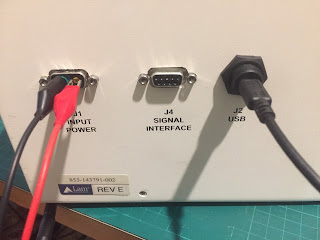found this interesting looking item
was advertised as
Lam RESEARCH / EXCELITE PAX-10 Precision-Aligned Pulsed Xenon Light Source

what i saw was a setup of a light source and a spectrometer
had to find out what is it even if it was a bit expensive
and so..
PAX-10 by excelitas xenon 10w light source

next was to find out what was the other unit, started to search some of
the numbers and found some horiba / jobin yvon spectrometer images that look similar
still needed to find the specific model, i think it is the VS-7000-CCD
but the specific model configuration specs is yet unknown

looks like the power is shared between the light source and spectrometer,
signal is a DB9 that goes to the xenon light source and continue to the spectrometer,
usb belongs to the spectrometer

pinouts:
PAX-10:
pin 1 -- Vin
pin 2 -- Vin
pin 4 -- Trigger -
pin 5 -- Trigger +
pin 6 -- Gnd
pin 7 -- Gnd
Spectrometer:
pin 3 -- to main unit DB9 (pinout 3)
pin 5 -- Trigger +
pin 9 -- Trigger -
so looks like there is an option to trigger both the spectrometer
and the light source from the main DB9

a close look at the fiber optic tip
xenon light source is the outer fiber bundle
while the inner fiber goes to the spectrometer

next step was to find the power needs which i knew was somewhere between 11-28v
just because it was written on the PAX-10

first thing is to define the power polarity
next was starting at 11v and go up until ill find some signs from the usb
at 23v i saw a green led light, rounded it to 24v as there isn't much difference
in between if you consider the power tolerance and 24 looks also more logical then 23
usb details:
idVendor 0x0c9b Jobin Yvon, Inc.
idProduct 0x000e

next step was checking the light source trigger was specify as 5v

looks like everything is working ,cool

wasn't a complete waste of money
might even find a good use to this setup even if not in its current configuration
first thing will be to replace the power plug with a more common one
still need to source the spectrometer driver so any help will be appreciated
to this moment didn't get any answer from Horiba / Lam RESEARCH